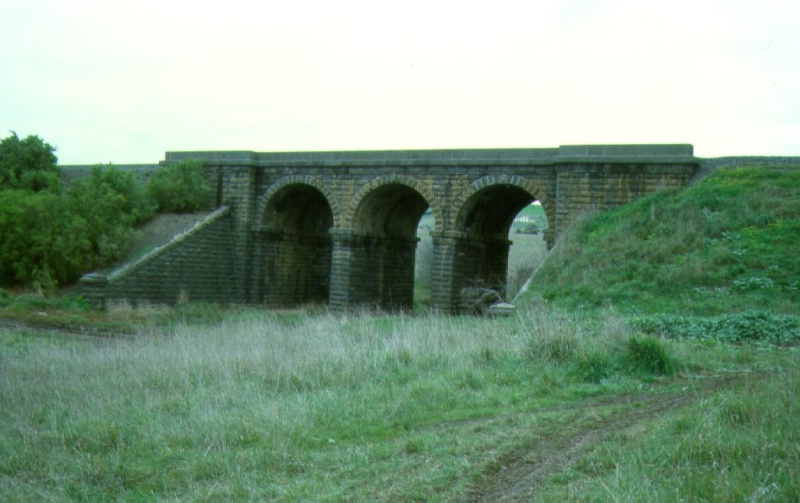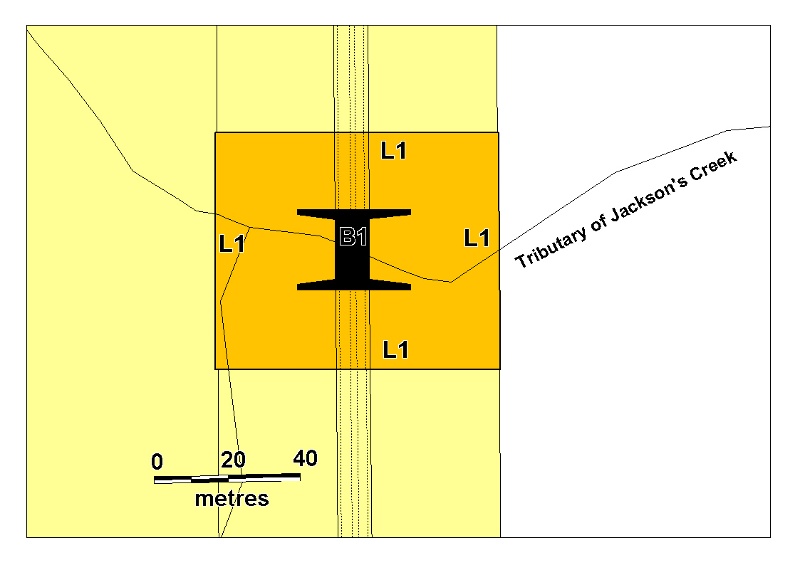RAILWAY BRIDGE
OFF VINEYARD ROAD (OVER JACKSONS CREEK TRIBUTARY SOUTH OF SUNBURY), SUNBURY, HUME CITY
-
Add to tour
You must log in to do that.
-
Share
-
Shortlist place
You must log in to do that.
- Download report




Statement of Significance
What is significant?
The Melbourne, Mount Alexander and Murray River Railway Company was established in 1852 to construct the main line from Melbourne to Mount Alexander and the River Murray (Echuca), along with a branch line to Williamstown. The government took over the project when the company was unable to raise sufficient funds to build the railway.
The Railway Bridge at Sunbury Hill was built in c. 1859 as part of the Melbourne - Echuca Railway which was the first government railway and the main trunk line of the Victorian railways, providing access to the Mount Alexander goldfields. The Railway Bridge was built by Cornish and Bruce under the direction of chief engineer G.C Derbyshire. Temporary construction camps were established at Sunbury and Riddells Creek to accommodate large working teams of men and horses. The first section of the line from Melbourne to Sunbury, was opened by the Victorian Railways Department on January the 13th, 1859. When the line was officially opened, this bridge had not been constructed as a result of the stonemasons strike which arose as a consequence of the lowering of wages, sub-contracting and the reintroduction of the 10 hour day by the contractors. A temporary timber structure served until the masonry structure could be constructed. This may explain an unusual feature of this bridge which is the separation of the arches between the two lines, indicating that the two sides were constructed separately.
The Railway Bridge, Sunbury Hill is set in a wide, open valley over a tributary of Jacksons Creek. The bridge consists of three semi circular (Roman) arches set on tall vertical sided piers. It is constructed of local bluestone. The broad flanking abutments with battered walls contain the tall embankment approaches. The bulk of the facework is quarry faced ashlar. The springing course and the soffit of the arches are in a smooth finish. The voussoirs, quoins, capping stones of the abutments and the two balustrade courses are in drafted edge quarry face.
How is it significant?
The Railway Bridge, Sunbury Hill is of historical and architectural significance to the State of Victoria.
Why is it significant?
The Railway Bridge, Sunbury Hill is historically significant as a major component of the bridge works of the Melbourne to Echuca Railway line, which was opened soon after the formation of the Victorian Railways Department in 1856. The line was exceptional for its high standards of construction, high costs and engineering achievements and displays a wide variety of stone bridges and viaducts.
The Railway Bridge, Sunbury Hill is architecturally significant as exemplary component of the railway infrastructure of the Melbourne to Echuca railway line, which was the largest building enterprise in the colony at the time. The high quality stonework and the heavy engineering of this bridge exemplifies the standards of construction along this line which were unequalled in later railway projects in Victoria. The Melbourne- Echuca line displays great variety in its numerous stone bridges including different stone types, finishes and designs. The Rail Bridge is also a notable contributing element to the dramatic landscape of Sunbury Hill. It forms part of a precinct of significant bluestone road and rail structures within the Sunbury district. The Rail Bridge is one of the oldest examples of the multi-span Roman arch bridge in Victoria.
-
-
RAILWAY BRIDGE - Permit Exemptions
General Exemptions:General exemptions apply to all places and objects included in the Victorian Heritage Register (VHR). General exemptions have been designed to allow everyday activities, maintenance and changes to your property, which don’t harm its cultural heritage significance, to proceed without the need to obtain approvals under the Heritage Act 2017.Places of worship: In some circumstances, you can alter a place of worship to accommodate religious practices without a permit, but you must notify the Executive Director of Heritage Victoria before you start the works or activities at least 20 business days before the works or activities are to commence.Subdivision/consolidation: Permit exemptions exist for some subdivisions and consolidations. If the subdivision or consolidation is in accordance with a planning permit granted under Part 4 of the Planning and Environment Act 1987 and the application for the planning permit was referred to the Executive Director of Heritage Victoria as a determining referral authority, a permit is not required.Specific exemptions may also apply to your registered place or object. If applicable, these are listed below. Specific exemptions are tailored to the conservation and management needs of an individual registered place or object and set out works and activities that are exempt from the requirements of a permit. Specific exemptions prevail if they conflict with general exemptions. Find out more about heritage permit exemptions here.Specific Exemptions:General Conditions: 1. All exempted alterations are to be planned and carried out in a manner which prevents damage to the fabric of the registered place or object. General Conditions: 2. Should it become apparent during further inspection or the carrying out of alterations that original or previously hidden or inaccessible details of the place or object are revealed which relate to the significance of the place or object, then the exemption covering such alteration shall cease and the Executive Director shall be notified as soon as possible. General Conditions: 3. If there is a conservation policy and plan approved by the Executive Director, all works shall be in accordance with it. General Conditions: 4. Nothing in this declaration prevents the Executive Director from amending or rescinding all or any of the permit exemptions. Nothing in this declaration exempts owners or their agents from the responsibility to seek relevant planning or building permits from the responsible authority where applicable. * Trackworks which do not impact on the structure or appearance of the bridge. * Maintenance to secure the structure in its current form. * Installation of pedestrian and cycle paths and low level landscaping. * Emergency works in the event of damage or failure of the structure.RAILWAY BRIDGE - Permit Exemption Policy
The purpose of the permit exemptions is to allow works that do not impact on the significance of the place to occur without the need for a permit. Track works and maintenance to the bridge that do not affect the structure or appearance of the bridge do not require a permit. Maintenance of an unimpeded setting to the bridge is important and any proposals for works by any authority which impact on the setting such as a road near or under the bridge, will be subject to the permit application process.
-
-
-
-
-
RAILWAY CONSTRUCTION CAMP SITE
 Victorian Heritage Inventory
Victorian Heritage Inventory -
Railway Viaduct
 National Trust H1964
National Trust H1964 -
Hesperocyparis macnabiana
 National Trust
National Trust
-
'Altona' Homestead (Formerly 'Laverton' Homestead) and Logan Reserve
 Hobsons Bay City
Hobsons Bay City
-
-











